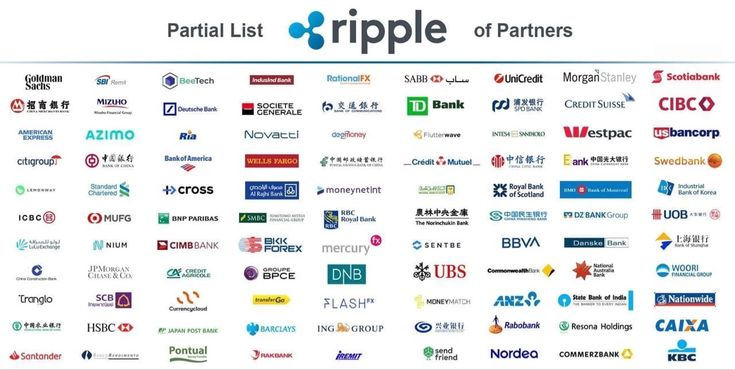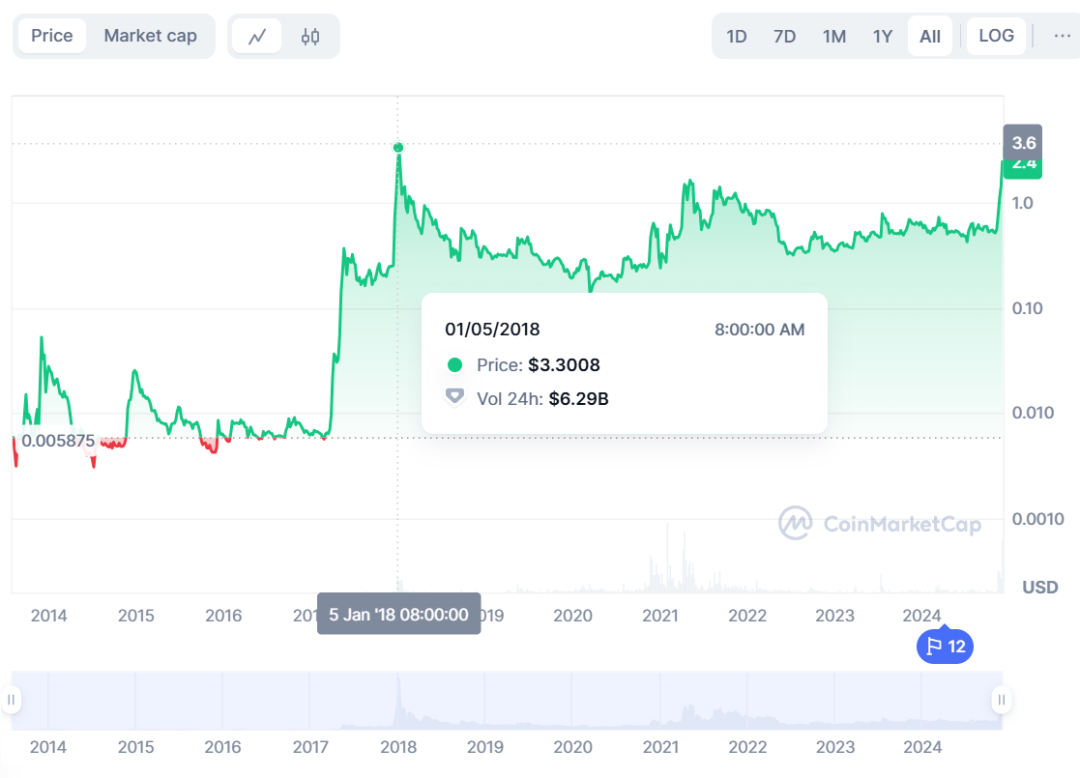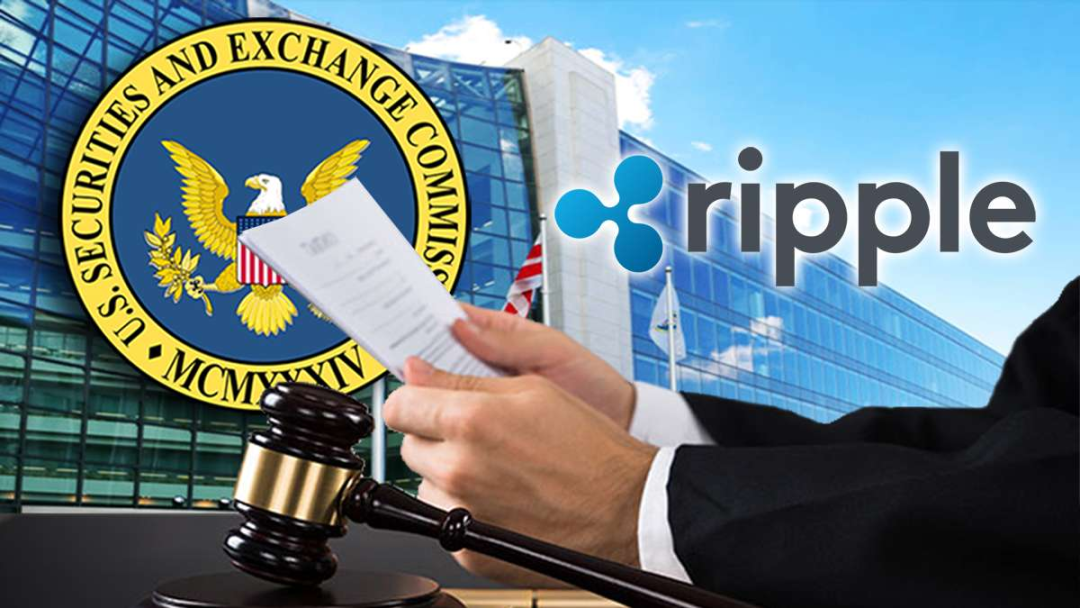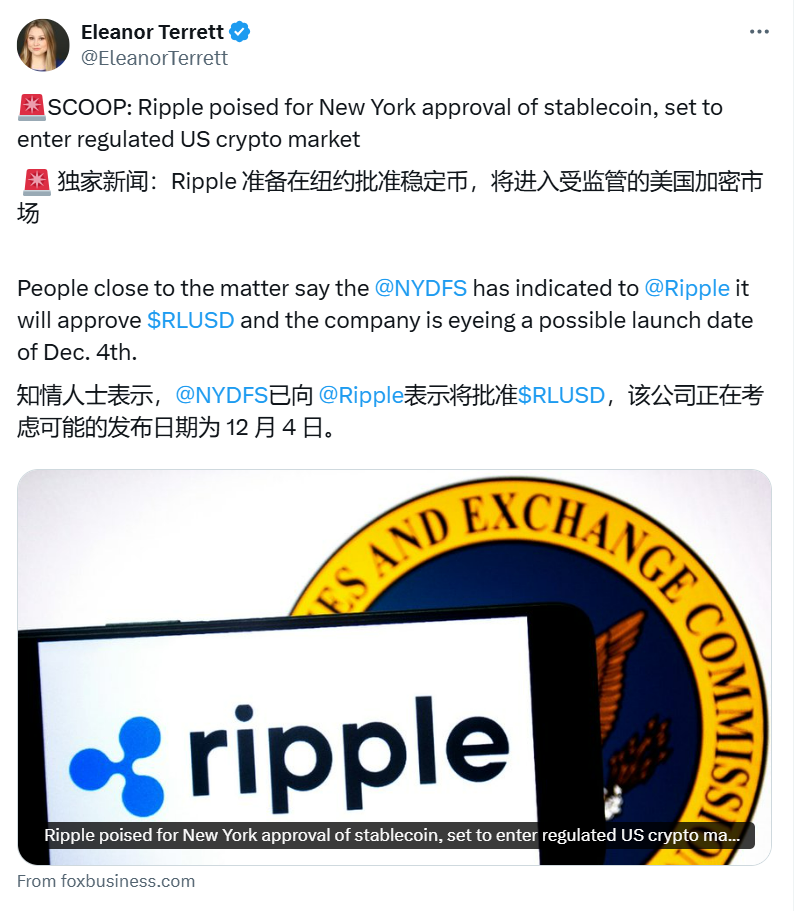Author | Huo Huo
Produced by | Plain Language Blockchain
Since Trump won the U.S. presidential election on November 5, a number of crypto assets led by Bitcoin have surged, with Ripple's XRP standing out even more. According to news on December 2, XRP surpassed Solana and Tether (USDT) to become the third-largest crypto asset by market capitalization, returning to levels seen before the SEC vs. Ripple lawsuit in 2020.
Ripple was once considered a prominent partner for many financial crypto institutions in adopting blockchain technology, representing one of the rare "footprints" of traditional "financial giants" participating in the wave of digital gold, blockchain, and PayFi technology. So, will Ripple be the "counterattack" of the financial giants this time?
01. Development History
Ripple's founding history can be traced back to 2004, initially created by developer Ryan Fugger as a payment platform called RipplePay. The goal of RipplePay was to enable individuals and businesses to make payments in a peer-to-peer manner without needing a bank account. Ryan Fugger designed a trust-based credit system that allowed users to transact or make cross-border payments directly based on mutual trust, eliminating the need for intermediaries in the traditional banking system, thus effectively reducing transaction costs.
In 2011, tech entrepreneurs Jed McCaleb and Chris Larsen took over RipplePay and decided to develop it into a blockchain-based payment system. In 2012, they founded OpenCoin to manage RipplePay, released the decentralized payment network protocol RippleNet based on the Ripple protocol, and began promoting XRP as a "bridge currency" for cross-border payments. As the business grew, in 2015, OpenCoin officially changed its name to Ripple Labs to better promote Ripple technology and the payment network.
It is worth mentioning that Chris Larsen was a well-known serial entrepreneur in Silicon Valley. In addition to Ripple, he founded E-Loan and Prosper, both of which achieved great success. Jed McCaleb was one of the founders of the early Bitcoin exchange Mt. Gox. Although Mt. Gox later collapsed due to security vulnerabilities and financial issues, McCaleb's early experiences provided him with deep insights into the crypto market and helped him build connections and reputation in the industry. Although he later left Ripple, he played a crucial role in its early development, helping Ripple build its core technology and ecosystem. The current CEO, Bradley Garlinghouse, has held executive positions at large companies like AOL and Yahoo!, and has extensive experience in the fintech and blockchain fields.
With the background of its founders and early advantages, Ripple has received multiple rounds of investment support since its establishment, attracting participation from many well-known venture capital firms. Investors include Andreessen Horowitz, IDG Capital Partners, Valar Ventures, Lightspeed Venture Partners, and others. This funding has provided Ripple with ample resources to drive its technology development and market expansion.
In terms of market development, Ripple not only targets ordinary users but also focuses on collaboration with traditional financial institutions. By 2013, Ripple had not only been tried by some small financial institutions but also collaborated with large financial institutions. By 2014, Ripple officially gained several partners, including cross-border payment companies like IDT Corporation and Earthport, and collaborated with many banks and financial institutions worldwide (such as Western Union, Spain's Santander Bank, PNC, etc.), changing the traditional cross-border payment model and making global payments more efficient and transparent, eliminating reliance on the foreign exchange market.

It is particularly important to note that Ripple Labs has two products: one is the Ripple protocol, which we mentioned is adopted by many banking institutions, and the other is the crypto asset XRP. These two concepts are easily confused, and people often mistakenly believe that banks are adopting the XRP asset on a large scale. In fact, the Ripple protocol adopted by banks is merely a payment and settlement solution that does not rely on the XRP crypto asset; XRP is just an optional asset during adoption. Overall, the Ripple protocol and XRP are compatible yet independent projects.
In 2018, Sun Yuchen also became Ripple's ambassador in China, responsible for promoting Ripple and XRP in the Chinese market.
In 2014, Ripple's predecessor company OpenCoin was named one of the "50 Smartest Companies in the World" by MIT Technology Review. Over time, Ripple has continuously strengthened its cooperation with global banks and payment institutions, gradually entering the mainstream financial circle, a trend also reflected in the price of XRP.
When XRP was first issued in 2012, its price was only a few cents. With the launch of the Ripple protocol and collaborations with some financial institutions, the price of XRP gradually rose between 2013 and 2014, reaching a peak of about $0.10. At the end of 2017, driven by a bull market in the entire crypto market, XRP experienced its first significant surge, especially in December 2017, when the price of XRP broke through $3, setting a new historical high and becoming the third-largest crypto asset by market capitalization at that time.

In 2018, with the market bubble bursting, the price of XRP fell back to around $0.50, entering a relatively stable period until the SEC filed a lawsuit against Ripple in 2020, accusing it of not registering XRP as a security. This case attracted widespread attention and became an important legal storm in the crypto industry, significantly impacting the price of XRP and causing it to decline.
Despite this, in 2021, with the overall market rebounding and some court victories, the price of XRP once rose to around $1.80. Entering 2022, due to ongoing legal regulatory challenges and unstable market sentiment, the price of XRP remained below $0.50 for most of the time. By 2023, Ripple achieved some victories in the lawsuit, restoring market confidence in XRP, and the price rose to around $0.90.

However, influenced by market sentiment, Ripple's business expansion, and the progress of legal proceedings, the price of XRP stabilized between $0.70 and $1.00 before November 2024, far from its peak period.
After experiencing a surge in November, by December 2, XRP's market capitalization surpassed USDT, becoming the third-largest crypto asset by market capitalization, returning to levels seen before the SEC vs. Ripple lawsuit. So, what factors have driven renewed interest in XRP?
02. Factors Behind the Surge
1) Turning Point in Ripple's Lawsuit with the SEC
The most direct factor behind XRP's rise stems from key developments in Ripple's difficult four-year lawsuit with the SEC.
Since 2020, the lawsuit between Ripple and the SEC has been a major obstacle to the rise in XRP's price. On December 22, 2020, the SEC formally filed a lawsuit against Ripple and its founders Bradley Garlinghouse and Christian A. Larsen, accusing them of profiting approximately $1.38 billion from the sale of XRP since 2013, claiming that XRP is an unregistered security that violates federal securities law registration requirements. Ripple insists that its actions are legal and has continuously defended itself in the lawsuit. Despite the ongoing litigation, under pressure from the SEC, several mainstream trading platforms like Coinbase and Binance US announced the delisting of XRP trading during this period.
However, recent developments in the case and the market indicate that the Ripple case may be on the verge of a proper resolution.
We know that SEC Chairman Gary Gensler's strict regulatory policies in recent years have plunged many crypto projects into difficulties, earning him the title of "crypto enemy." However, with news that Gensler will step down in January 2025, market expectations for a more favorable regulatory environment have been ignited. More importantly, this also means that the long-standing legal dispute between Ripple and the SEC may be approaching resolution.

According to a report by Bitcoin.com on December 2, former CFTC Chairman Chris Giancarlo stated that under a crypto-friendly government leadership, the SEC may withdraw its lawsuit against Ripple. He believes that the Trump administration may shift towards more supportive policies for crypto, and the SEC will also re-evaluate its regulatory stance on crypto assets, including its classification of XRP. Giancarlo has also written a legal analysis report arguing that XRP should not be considered a security and has consistently advocated for increased regulatory transparency and a more lenient approach to digital assets.
Previously, The Washington Post reported that Trump's advisory team is evaluating several candidates, including some officials and financial executives who openly support the crypto industry. Notably, Chris Giancarlo is seen as a strong candidate for the position of "crypto czar" in the Trump administration.
There is no doubt that the market is predicting that the new SEC leadership may adopt a more lenient and supportive attitude towards the crypto industry, thus bringing new opportunities for XRP and other projects that have faced regulatory pressure. It is foreseeable that if the new chairman promotes a policy shift, Ripple's lawsuit may be resolved or withdrawn, and the regulatory environment for the entire crypto industry may change. This would be a significant policy boon for projects like Ripple, Binance, and Coinbase that have faced suppression. Under this favorable influence, the price of XRP rebounded strongly, with a single-day increase exceeding 35%, setting a new high in nearly three years.
2) The Trump Administration's Friendly Attitude Towards Crypto Development
In the 2024 U.S. presidential election, the dust has settled, and Republican candidate Donald Trump has been elected as the next president. During his campaign, Trump promised to make the U.S. the "global cryptocurrency capital" and strongly support the crypto industry, as detailed in a previous article: "Breaking: Trump Wins, Bitcoin Welcomes the Most Friendly U.S. Government." This news has brought significant confidence to the market, initially driving up the prices of crypto assets led by Bitcoin, pushing Bitcoin to aim for the $100,000 mark.
Moreover, on November 14, reports emerged that President Trump hopes to eliminate all capital gains taxes on cryptocurrencies issued by U.S. companies. This news would make all profits from ADA, ALGO, HBAR, and XRP completely tax-free, as their creators are all U.S. companies.
It can be said that the improvement in the regulatory environment has become a major favorable factor for XRP's turnaround. With the overall market trend pushing the prices of mainstream crypto assets like Bitcoin and Ethereum upward, the crypto market has entered a new bull market cycle. As one of the leading crypto assets by market capitalization, XRP naturally became a focal point of capital attention.
3) Ripple's Development Potential
For decades, the global financial payment system has been dominated by traditional bank settlement and payment methods. While these systems have advantages in stability and security, many issues have gradually emerged with the acceleration of globalization and the booming of e-commerce: high transaction fees, slow payment processing speeds, and the complexity and high costs of cross-border payments have become bottlenecks restricting global financial liquidity and market development.
The XRP and XRP Ledger (decentralized ledger) launched by Ripple differ from Bitcoin and Ethereum, which rely on Proof of Work (PoW) or Proof of Stake (PoS). XRP uses the Ripple Protocol Consensus Algorithm (RPCA). This algorithm reaches consensus through a set of independent validating nodes, ensuring rapid and effective verification of transactions. This allows the XRP network to complete transaction verification in seconds, greatly increasing transaction speed and reducing costs, while XRP essentially serves as a bridge currency, enabling efficient and low-cost exchanges between different fiat currencies, providing a smoother path for global payments and cross-border settlements.
With its innovative technological architecture and unique business model, Ripple has become an important force in driving the innovation of traditional financial payment systems and expanding into the Web3 space. It has established deep partnerships with over 100 banks and financial institutions worldwide, including well-known institutions like Santander Bank and Mitsubishi Bank. These collaborations not only enhance Ripple's influence in the traditional financial sector but also provide more practical application scenarios for XRP. Additionally, Ripple is actively promoting the tokenization of real-world assets (RWA) in collaboration with platforms like Archax, helping traditional financial assets smoothly enter the blockchain ecosystem. Furthermore, Ripple is also actively laying out in the "institutional DeFi" space, opening new opportunities for further collaboration with financial institutions by investing in projects like tokenized government bonds through partnerships with platforms like OpenEden.
Therefore, Ripple has practical use value and demand in areas such as cross-border payments and liquidity management.
Recently, asset management companies like 21Shares and Bitwise Asset Management have submitted proposals for an XRP ETF, further validating Ripple's strategic advantages in the integration of Web3 and traditional finance.
In addition, according to reports from CoinDesk, Ripple Labs has invested $25 million in the Fairshake Political Action Committee (PAC) in the crypto industry, aiming to compete for a seat on the crypto industry advisory committee that Trump plans to establish and influence the 2026 U.S. congressional elections to promote more favorable crypto regulatory policies. This move by Ripple marks the company's beginning to utilize political means, attempting to reverse its litigation predicament with the SEC through policy reform and secure a more favorable legal and regulatory environment for XRP.
According to a Fox Business report on November 30, the New York Department of Financial Services has hinted at approving the company's innovative RLUSD stablecoin, which is closely related to XRP. If approved, Ripple will be able to legally offer RLUSD to the public.

There are also unverified reports that Elon Musk may make significant investments in Ripple and XRP, which could further amplify market excitement. However, this rumor remains speculation, but it may have contributed to the bullish momentum of XRP.
03. Risk Warning
Despite XRP's recent strong performance, its future trajectory should be viewed rationally.
1) Centralization Issues
First, the initial token distribution of XRP is controversial. Of the total supply of 100 billion XRP, more than half is controlled by Ripple Labs.
Secondly, unlike fully decentralized blockchains like Bitcoin and Ethereum, Ripple Labs plays a core role in the development, maintenance, and support of the XRP Ledger. This dependency means that the XRP Ledger is somewhat subject to the decisions of Ripple Labs.
Additionally, Ripple Labs has established partnerships with many traditional financial institutions and central banks, which typically have centralized structures.
2) Leverage Bubble Risk
The sharp rise in XRP has pushed its price to the highest level since 2021. Some analysts warn that this increase may be "leverage-driven," as the open interest in XRP derivatives has reached record levels, cautioning investors to be aware of potential volatility. Historical patterns indicate that a rapid increase in open interest often leads to sudden market corrections.
3) Confusion Between Ripple Protocol and XRP
As mentioned earlier, many people completely conflate the large-scale adoption of the Ripple protocol by financial institutions with the large-scale adoption of the XRP asset. The two are compatible yet independent; although the Ripple protocol creates a strong background for the XRP asset, confusing the two could lead to misjudgments in overall assessments.
04. Conclusion
As one of the pioneers in the blockchain field, XRP has focused on cross-border payment scenarios since its launch in 2012, gaining favor from financial institutions due to its efficiency, low cost, and technological innovation. However, over the past 12 years, XRP's growth path has not been smooth, facing pressure from market competition and frequent setbacks due to regulatory controversies. As a "veteran" in the cryptocurrency field, whether XRP can successfully carve out innovative paths in the future remains to be seen.
免责声明:本文章仅代表作者个人观点,不代表本平台的立场和观点。本文章仅供信息分享,不构成对任何人的任何投资建议。用户与作者之间的任何争议,与本平台无关。如网页中刊载的文章或图片涉及侵权,请提供相关的权利证明和身份证明发送邮件到support@aicoin.com,本平台相关工作人员将会进行核查。




